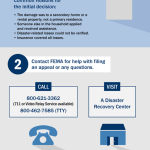BATON ROUGE, La. — Submit your U.S. Small Business Administration (SBA) low-interest disaster loan application now to prevent missing out on potential funding for your recovery.
An SBA loan can help repair flood-related damage to your home or business and replace personal property. SBA representatives provide one-on-one assistance through the entire disaster loan process to assist in your recovery.
Landlords and most private non-profits, including churches, are eligible for low-interest SBA disaster loans. State and federal recovery officials encourage them to apply.
A loan offer provides the financial resources to pay for repairs if the SBA approves your application. You are under no obligation to accept the loan if approved.
You must return a completed SBA disaster loan application by Monday, Nov. 14, if you want to borrow money for repairs.
It is a critical recovery step to return a loan application. The SBA may refer you back to FEMA for other potential grants if they cannot offer you a loan. The grants may pay for flood-damaged furniture, appliances and vehicles.
The SBA provides low-interest disaster loans of up to $200,000 to repair your primary residence, up to $40,000 for homeowners and renters to replace personal property and up to $2 million to businesses and most private non-profits for physical damage and economic injury needs as a result of the disaster.
Learn more and visit sba.gov/disaster or call 800-659-2955 or TTY 800-877-8339. If you use 711 or Video Relay Service, call 800-659-2955.
More:




